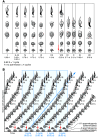The key role of vitamin A in spermatogenesis
- PMID: 20364093
- PMCID: PMC2846058
- DOI: 10.1172/JCI41303
The key role of vitamin A in spermatogenesis
Abstract
Spermatogenesis in adult mammals is highly organized, with the goal being continual sperm production. Vertebrate testes are arranged into recurring cellular associations that vary with time and distance along the tubule. These changes over time and distance are designated the cycle of the seminiferous epithelium and the spermatogenic wave, respectively. In this Review, we briefly outline the roles that follicle-stimulating hormone (FSH) and testosterone play in regulating spermatogenesis and describe our current understanding of how vitamin A regulates germ cell differentiation and how it may lead to the generation of both the cycle of the seminiferous epithelium and the spermatogenic wave.
Figures




References
-
- de Rooij DG, Russell LD. All you wanted to know about spermatogonia but were afraid to ask. . J Androl. 2000;21(6):776–798. - PubMed
-
- Russell LD, Ettlin, RA, Sinha Hikim AD, Clegg EP.Histological and histopathological evaluation of the testis. Clearwater, FL: Cache River Press; 1990.
-
- Kerr JB, Loveland KL, O’Bryan MK, deKretser DM. Cytology of the testis and intrinsic control mechanisms. In: Neill JD, ed.Physiology of reproduction. New York, NY: Elsevier; 2006:827–947.
-
- Yan HH, Mruk DD, Cheng CY. Junction restructuring and spermatogenesis: the biology, regulation, and implication in male contraceptive development. Curr Top Dev Biol. 2008;80:57–92. - PubMed
Publication types
MeSH terms
Substances
Grants and funding
LinkOut - more resources
Full Text Sources
Other Literature Sources
Medical

